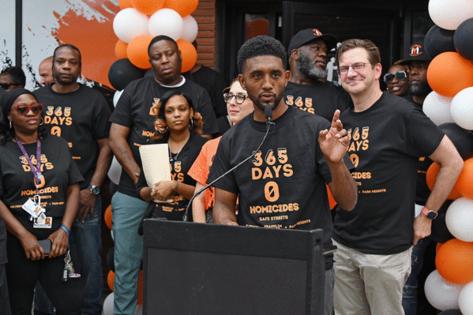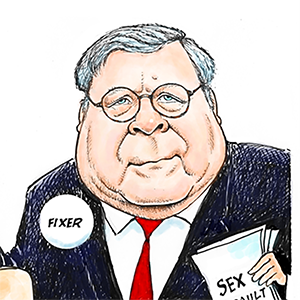Baltimore gave $61 million -- 10% -- of its COVID funds to public safety. Where did it go?
Published in News & Features
BALTIMORE — Over the past 3 1/2 years, Baltimore has had millions of extra dollars to spend on public safety, thanks to the federal government.
The city received a total of $641 million through the American Rescue Plan Act in 2021, signed into law by President Joe Biden to address the COVID-19 pandemic and economic instability caused by government shutdowns. Local jurisdictions were given wide leeway on how to spend the funds, including to address problems like crime.
Baltimore allocated a similar amount of funds to public safety as other cities, but there was a key difference: In contrast with other cities, Baltimore devoted a far greater portion of its spending to violence reduction and prevention efforts than it did to police.
“As a city, we must embrace a more holistic strategy grounded in the immediate action we can take today while simultaneously addressing the root causes of violence — that’s the only way we will sustain reductions in crime,” Mayor Brandon Scott said in 2020, regarding the launch of the city’s neighborhood safety office, shortly before COVID-19 funding was rolled out to assist the effort. “We must no longer subscribe to the thinking that police alone can stem the tide of violence.”
City officials credit violence prevention and reduction efforts with reducing Baltimore’s homicide rate and nonfatal shootings. Others point to police and Baltimore City State’s Attorney Ivan Bates as effective in reducing crime and say more COVID-19 funds should have been allocated to the police department.
Biden has said there’s a need for both violence prevention and police.
Others outspent Baltimore 3 to 1 on police
Most of Baltimore’s COVID-19 relief funds are now obligated, with around 10.3% — or $61 million — allocated for public safety, according to a “Local Government ARPA Investment Tracker,” an online resource compiled by Brookings Metro, the National Association of Counties, and the National League of Cities. Baltimore’s spending on public safety is slightly higher than the 9.1% average spent on public safety by the 92 cities and consolidated city-counties included in the project.
Violence prevention is based on the idea that violence is a social phenomenon or public health issue with preventable causes, and that potential sources of violence should be addressed ahead of time rather than after violence breaks out. Proponents say the approach has been proved to work, while opponents say the evidence is scanty, and the most effective antidote to crime is investing in police.
Baltimore allotted 74.2% of its COVID-19 public safety funds to violence reduction and prevention efforts, 15.2% to the fire department, and 10.5% to police, according to the ARPA fund tracker. The other local governments spent nearly three times as much of their COVID-19 public safety budgets exclusively on police — 28.3% — compared with 19% for violence reduction and prevention, 9.3% on fire departments, and 43.2% on “other public safety.” The last of those refers to projects that fund more than one department, including police, fire and social work.
‘Meaningful solutions’
Most of the city’s violence reduction and prevention funds were administered through the Mayor’s Office of Neighborhood Safety and Engagement (MONSE), which includes the city’s Group Violence Reduction Strategy. The program offers resources to people who have an “acute risk of involvement in gun violence,” while also collaborating with police and the state’s attorney’s office, according to the city’s website.
Per a July report, GVRS had 549 total participants, including 169 enrolled in “intensive case management,” where they are assigned to a life coach who provides services such as safety relocation, education, job training, cognitive behavioral therapy and touching base with participants three to five times per week. The program helped 45 participants with housing relocation and 110 with stipends.
“The Mayor’s ARPA allocation toward our agency is really about building meaningful, community-driven, public health solutions to violence,” said Jack French, chief of communications for MONSE, in an email.
Another program, Safe Streets, employs “credible messengers,” which has included ex-felons, to reduce violence by mediating conflicts. Begun in 2007, Safe Streets received ARPA funding starting in 2022, with a total of 715 mediations for the Sandtown, Brooklyn and Cherry Hill neighborhoods.
The program has stirred controversy a few times in the past over criminal allegations against employees. But city officials say it’s working, with three Safe Streets neighborhoods recently reporting no homicides in the past year.
Salaries account for 14.8% of the funds out of the total $40 million given to MONSE through ARPA, French said. The people in those positions primarily support community engagement, data analysis and victim services work, he said.
MONSE also has programs for victim services helping communities heal from traumatic events, including a “Peace Mobile” that includes a “Beats Not Bullets” recording studio, computers to help people connect to services, and video and board games for kids.
In addition to the MONSE funding, the city awarded a violence prevention grant to the Pride Center of Maryland, totaling $250,000.
‘Fringe beliefs’
While many praise the violence prevention efforts, Peter Moskos is skeptical. He worked for the Baltimore Police Department for two years as part of his dissertation research before becoming a professor at the John Jay College of Criminal Justice at the City University of New York. He says alternatives to policing are based on the “false belief that police are the problem rather than part of the solution,” he said.
“These used to be really fringe beliefs that were kind of cute to debate theoretically, until people started taking them seriously,” he said. “Do we want police chasing criminals? Like, the idea that that is debatable, and often the answer is ‘no’ — I mean, that’s mind-blowing to me.”
Violence interruption programs are “charitably, very hit or miss” in terms of results, said Charles Fain Lehman, a fellow at the Manhattan Institute, a New York-based think tank that aims to advance “opportunity, individual liberty and the rule of law” in American cities. Lehman cited a study in the Journal of Criminology last year, showing a multiyear violence intervention program in Boston had “no detectable effect on violence among the gangs that it served.”
A drastic drop in homicides
French credits both MONSE and the police department for the drastic drop in city homicides and nonfatal shootings over the past two years. A study from the University of Pennsylvania’s Crime and Justice Policy Lab estimates that GVRS reduced homicides and shootings in Baltimore’s Western Police District by about a quarter, and reduced carjackings by about a third. Researchers added that they found no evidence that crimes in that district moved to other areas in the city.
Lehman said the homicide rate decline could be a result of both MONSE’s efforts and new prosecutorial policies implemented by Bates since he took office in 2023.
Biden endorsed both violence prevention and policing in his 2022 State of the Union address, saying jurisdictions should use ARPA funds to “hire more police” and also invest in “community violence interruption, trusted messengers, breaking the cycle of violence and trauma and giving young people some hope.” He added: “The answer is not to defund the police. It’s to fund the police.”
Other cities boosted police salaries
The portion of public safety funds allotted for police through ARPA came in the form of new hybrid vehicles that had been requested by the department, and which have resulted in “savings on repair and fuel costs,” police spokesperson Lindsey Eldridge said in a statement. Eldridge did not respond when asked whether the police department made any other requests for COVID-19 relief funds, such as personnel salaries.
Other cities allotted a higher percentage of ARPA public safety funding to police departments, including Los Angeles, which allocated more than $300 million for sworn police officer salaries. Detroit approved $5 million for police bonuses. Tulsa, Oklahoma, handed out police hiring stipends and retention bonuses. All three cities saw a significant drop in homicides in 2023.
If it were his decision on what to do with ARPA funds, Lehman said he’d invest more in police hiring and logistics. Baltimore’s police department in September had more than 549 sworn officer vacancies and 1,981 sworn officers on the job.
“We really have a lot of high-quality evidence that more cops on the street is … one of the most effective ways to reduce crime,” he said. He cited a study of the Dallas police department showing a 10% decrease in police presence correlating with a 7% increase in crime.
A spokesperson for Scott didn’t respond to questions about violence prevention and whether there was any consideration to use the ARPA funds to fill vacancies.
Are the city violence prevention programs working?
Asked in a September interview whether he thinks GVRS and Safe Streets are working, City Councilman Mark Conway, who chairs the council’s Public Safety and Government Operations Committee, replied that it’s “a complicated question.”
“I think there are some instances where Safe Streets is working really, really well and has strong relationships in the community,” he said. “And when violence does pop up, or there are beefs or squabbles, Safe Streets is very able to step in and intervene and prevent that from turning into a shooting or homicide.” He added that GVRS has “begun to show some of the benefits that we expected it to see,” but that there are other contributing factors to the reduction in homicides and shootings.
Crime is on a steep decline this year in Baltimore, with homicides down 28% from last year, property crimes down nearly 20%, and violent crimes down 8%, with the exception of rape — up 15%, according to the city’s public safety accountability dashboard. Last year, there was a steep decline in homicides, little change in violent crimes, and a 43% rise in property crimes.
Comptroller Bill Henry, who sits on the city’s spending board that approves ARPA allocations, said he’s inclined to support the city’s violence prevention initiatives.
“[O]ne of my basic political positions is that it is more effective to spend money preventing crime — in this case, through violence interruption — than it is to spend money on policing criminals after the fact,” he said in an emailed statement. “ARPA money is temporary, so using it to temporarily expand the scope of MONSE’s pilot programs and gather more data on their effectiveness makes a lot of sense.”
--------
©2024 The Baltimore Sun. Visit at baltimoresun.com. Distributed by Tribune Content Agency, LLC.







Comments